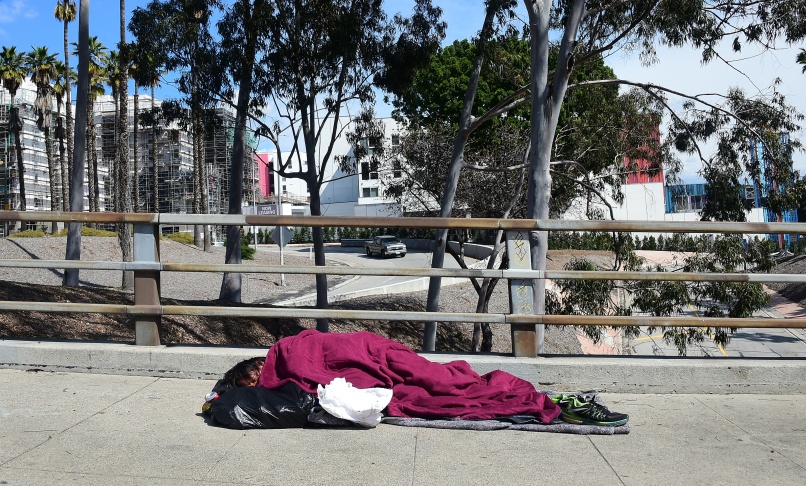
L.A. County plans to use a new computer modeling tool to predict who is about to become homeless. The goal is to identify people on the edge and then reach out with financial aid and other help to keep them in their homes.
"We will be complementing existing programs with proactive efforts to identify and reach out to, at this point, single adults who we've identified as at greater risk of becoming homeless," said Phil Ansell, director of the L.A. County Homeless Initiative, which oversees homeless funding raised through Measure H.
Officials detailed their new prevention plan this week: A special county prevention unit, armed with $3 million in funding and a mission to reduce the number of people joining the nearly 60,000 who are already homeless across L.A. County.
Predicting homelessness is easier said than done.
Nearly 2 million single adults are receiving various public services in L.A. County. In theory, many of them are the kind of poor and precariously housed people who could easily spiral into homelessness after one missed paycheck, medical emergency or other financial shock.
But less than 2% of those county clients actually become homeless in any given year. The challenge is to pinpoint who's at greatest risk of losing their home in order to decide how best to spend limited prevention funds.
That's what led researchers with the California Policy Lab at UCLA to develop a new predictive model that aims to pick up on the risk patterns that human service providers can't always see on their own.
Researchers say local governments stand to save money in the long run if small amounts of short-term help can successfully keep people out of shelters and off the streets.
"What we're really trying to do is to get to more people sooner, with a less expensive intervention that changes the course of their life," said Janey Rountree, executive director of the California Policy Lab at UCLA.
HOW TO PREDICT HOMELESSNESS?
The researchers built their model using data on current clients of various county programs, such as CalFresh and General Relief. After combing through millions of service records from 2012 through 2016, the researchers came up with a list of the 3,000 clients they thought had the highest risk of becoming homeless in 2017.
When they compared their findings with a list of people who actually became homeless in 2017, they found that their predictions were correct nearly half the time (46 percent, to be exact).
The researchers say that's a pretty strong result, given the complexity of predicting homelessness. Those who ended up on the list were 27 times more likely to become homeless than the average user of county services.
So what do those who ended up on the list have in common? Rountree said no clear profile emerged from the research, but people who become homeless tend to use public services in some telling ways.
"They tend to be more engaged with county services," she said. "They tend to receive county services at multiple locations. And they tend to be served in areas that are experiencing very high levels of poverty."
Moving forward, the county will use this predictive model to come up with a list of people who appear to be at high risk of becoming homeless. The new prevention unit will then reach out to those on the list.
Help could come in the form of covering back rent to avoid an eviction or help paying an overdue utility bill. Officials say the type of prevention funding will vary for each client. But the goal will be to use short-term aid to keep people in their current homes.
'EVERY ARROW IN OUR QUIVER'
The county's new plan comes at a time when local leaders are increasingly calling for more action on homeless prevention. About 150 people become homeless in L.A. every day, outpacing the 133 people, on average, who come off the streets here each day.
Officials tempered expectations for the new tool, but said it could reduce new flows into homelessness. A narrowly targeted list of those at highest risk could include about 3,000 people. That's only a fraction of the 33,600 users of county services who become homeless every year.
"The work that we're describing today will not lead to an enormous overnight shift in the number of people who are becoming homeless," Ansell said. "But we need to use every arrow in our quiver to combat this crisis."
The county could try to cast a wider net. But the predictive model becomes less reliable as it tries to identify more people.
Focusing on current clients of county services makes sense, researchers say, because the majority of people becoming homeless are already tapped into various county programs.
This approach has not yet been proven in other cities. Prevention programs in places like Chicago and New York have been shown to be effective. But they rely on screening clients who come to the local homeless services system asking for help.
James Sullivan, a Notre Dame economist who has studied Chicago's prevention call center, said, "Using the power of data and predictive analytics can help communities better target limited resources."
He said the L.A. plan is new in this field, and it "could serve as a model for homelessness prevention in communities across the country."
"computer" - Google News
December 18, 2019 at 09:00PM
https://ift.tt/2Sg9nP5
Can Computer Modeling Predict Who Will Become Homeless? LA County Is Betting On It - LAist
"computer" - Google News
https://ift.tt/2PlK2zT
Shoes Man Tutorial
Pos News Update
Meme Update
Korean Entertainment News
Japan News Update
No comments:
Post a Comment